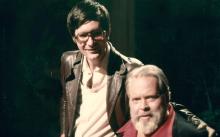Cinema Professor Helps Rescue Long-Unseen Orson Welles Film

Pinned to the lapel of his weathered brown sports coat, San Francisco State University School of Cinema Professor Joseph McBride wears a small black button that reads “VISTOW.” That’s an acronym for “Volunteers in Service to Orson Welles,” an elite group of actors and cinephiles who have helped rescue one of the legendary director’s lost projects from movie limbo. Thanks to their efforts, the film — the till-now uncompleted The Other Side of the Wind — can be seen on Netflix starting November 2.
Best known for his 1941 classic Citizen Kane, Welles started shooting The Other Side of the Wind in 1970. A satire of Hollywood that focuses on the final day of an aging director, the film had a long, on-again, off-again production — which McBride got to see up close. A 23-year-old film scholar at the time, he was cast in the film as a gauche, socially awkward critic after a colleague he’d called, actor and director Peter Bogdanovich, put him on the line with Welles, who surprisingly gave him the part.
“I represent sort of the film buff world, and he was making fun of us,” said McBride, who’s taught cinema history and screenwriting at San Francisco State since 2002. “It’s an ambivalent film about the media … The story of this famous man being swallowed up by his own media image.”
McBride’s role didn’t exactly earn him a big payday: He says Welles paid him for his time with “two boxes of cheap cigars.”
“I never smoked them. I just thought it was sweet that he sent me them,” said McBride. “We weren’t in the film for the money. It was all to help Welles.”
Unfortunately for Welles, by that stage of his career he needed all the help he could get. Principal photography on The Other Side of the Wind took six years, and the editing and post-production process would drag on far longer. According to McBride, Welles could not find funding in Hollywood and went to the Shah of Iran’s brother-in-law in Paris for financial support. Following the Iranian Revolution in 1979, the ayatollah went after the assets of the royal family, including the film. When Welles died in 1985, The Other Side of the Wind remained unfinished and unreleasable.
In the 1990s, McBride and other members of the cast and crew attempted to rescue the film. But once again, Hollywood was unwilling to support the project.
“We went to Steven Spielberg, George Lucas, Clint Eastwood and Oliver Stone,” McBride recalled. “All these people — they just wouldn’t put up the money.”
Cut to 2015, however, and The Other Side of the Wind would finally get its happy ending: Netflix executives forked over $6 million to support the film’s editing and release. McBride was hired as a consultant, giving his feedback to producers in a 26-page, single-spaced memo. In addition to appearing on Netflix, the film will be screened at select theatres around the country, including San Francisco’s Roxie November 2 to November 4.
“I feel a sense of accomplishment. We’ve all done a tremendous thing here, and I contributed my part,” said McBride. “To save this film from being thrown away and deteriorating is a major contribution to film history.”
McBride, who still keeps his vintage costume from the film folded up in a box at home, has come a long way since the early 1970s. He’s written 20 books on film, most recently a critical study of the film director Ernst Lubitsch, published this past summer by Columbia University Press. McBride will teach an SF State class on Lubitsch next fall.
But despite all his success as a serious film scholar, McBride says one of his greatest achievements in the world of cinema was simply getting Orson Welles to laugh.
“He thought I was funny,” McBride said, grinning at the memory. “He encouraged me to be my goofy self. I was this very earnest young guy, and he encouraged that. It’s such an honor to have worked with him, and him having faith in me.”
— Ivan Natividad
Links
Photo: SF State Professor of Cinema Joseph McBride on the set with legendary filmmaker Orson Welles.